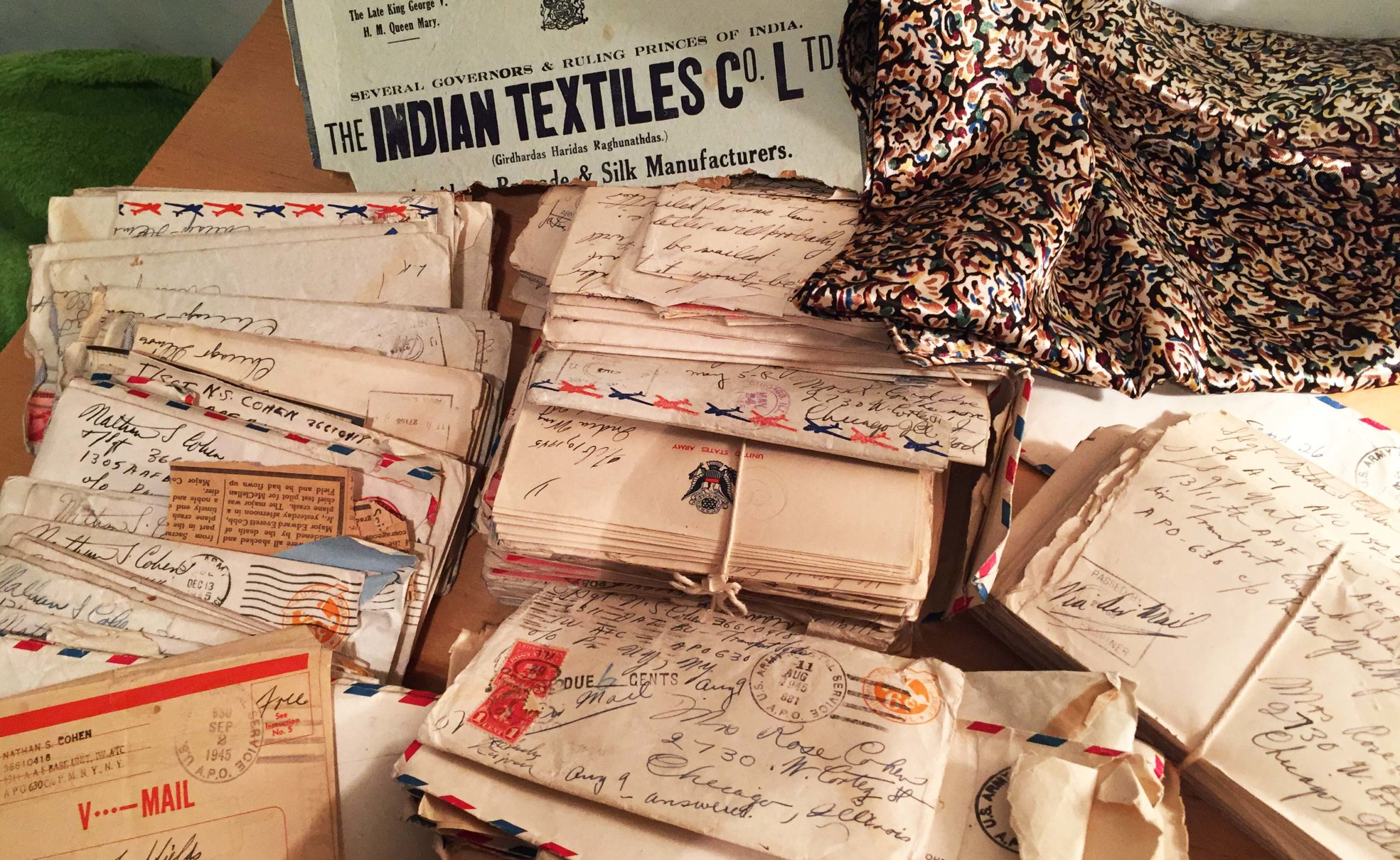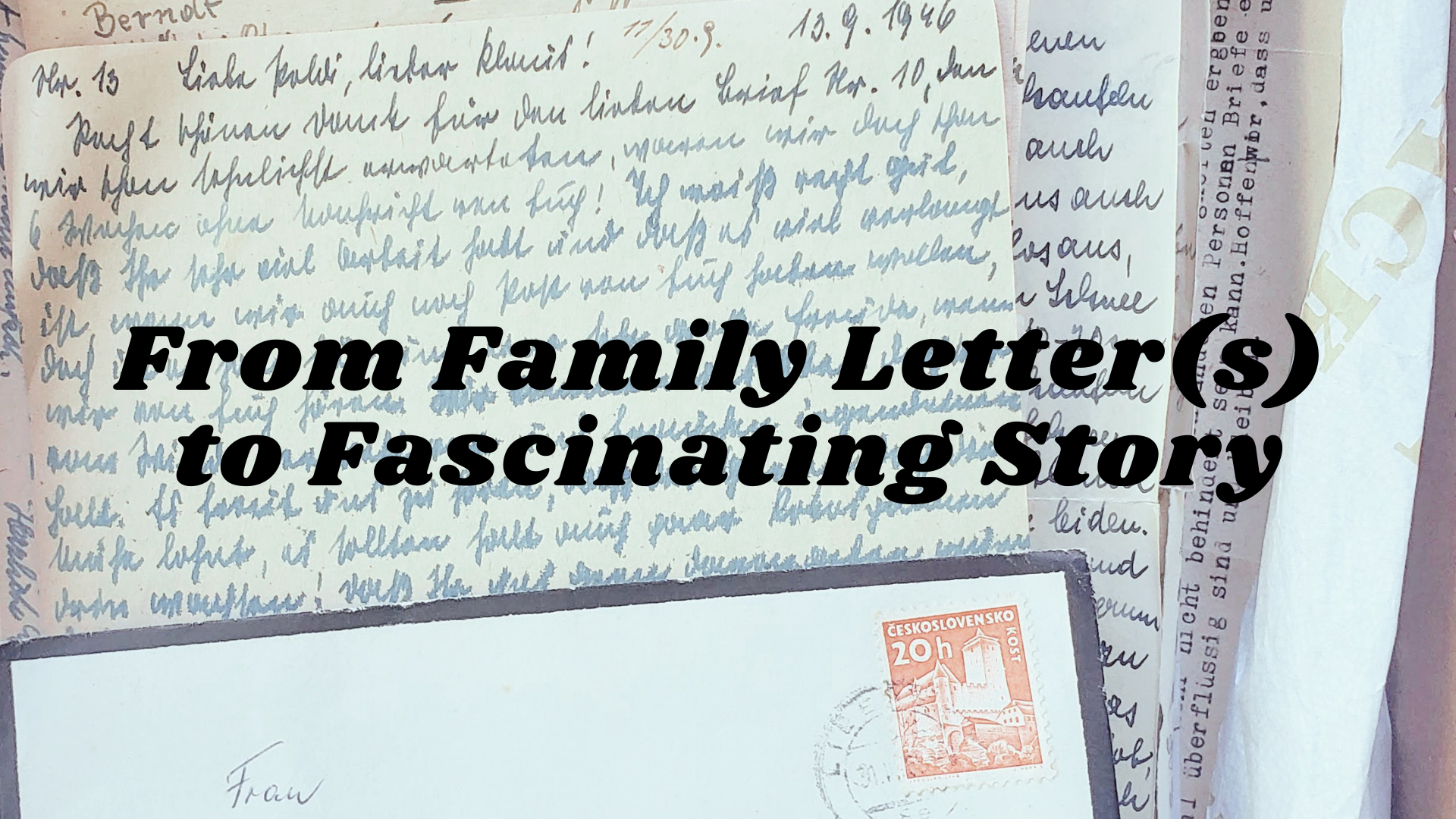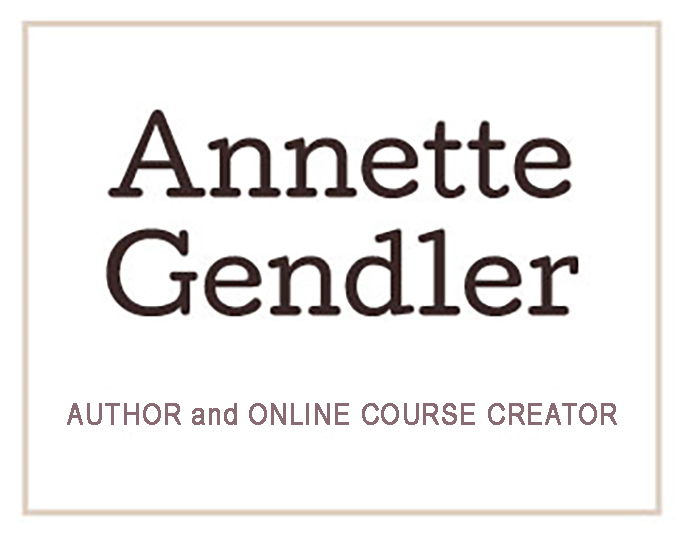
The pile of letters the father of my reader Donna sent to his sister in Chicago while he was stationed in India during WWII, including the silk he sent for making a dress.
Writing family history based on a cache of old letters is a particular challenge. However, it is so worthwhile!
Letters provide a personal lens on history. They answer the question, “What was it like (to live through the Great Depression, or fight in Vietnam, or get through the Spanish Flu Epidemic…)?”
Letters give us a portrait of the one who wrote it, and often the recipient as well.
Nevertheless, “doing something” with such a pile of letters can be daunting, so let me share a few tips on how to get started.
My reader Donna, who lives in Israel, has just such a treasure trove of letters and sent this query to my advice column (you can still ask questions here):
“About 10 years ago my aunt gave me a box of my father’s letters to her. In 1940, at the age of 19, my father became a soldier in the US army and was sent to India. He had hard experiences and missed his family. I read a few of his letters and some really hit me because he said things like: “It’s horrible what’s happening to our people in Europe,” or “the future of our people is in Palestine.”
I want to write a book using his letters. My father was a first generation American serving in the army. It was his first time away from home and in a foreign country. Seeing the poverty in India as well as the life of the upper castes really affected him. He went to synagogues for the holidays and traveled to many areas of the country.
I don’t know how to go about getting started with this.
Now that I have retired, I planned on making this a project. Every time I open a letter, I feel like my father is talking to me, and I know that I am living his dream. He visited me four times and loved Israel. Sadly he died in 1986 of a sudden heart attack.
After my aunt died two years ago, my cousin found the silk that my dad had mailed to my aunt from India to make herself a nice dress. Sadly, she never did. I brought the silk to Israel, and a seamstress suggested that I could have her make scarves for all the women in the family. The silk is in perfect condition, still wrapped in tissue paper!
So, how do I begin with this project?”
Here are my tips:
Start with that piece of silk.
Here’s why:
- The silk gives you a concrete and tangible place to begin. Describe this piece of silk, including colors, pattern, size, and texture.
- It sounds like that pile of letters overwhelms you, so look for the one letter that accompanied that piece of silk and quote from it. This gives you an opening to capture your dad’s relationship with his sister.
- Next, include some backstory. The lack of context is one of the main issues when using letters as the basis for a story. So:
- Research exactly where your dad bought the silk. Where was he located then?
- From your image it looks like you have the original package of the Indian Textile Co. What can you find out about that company? Information like that will provide a bit of local color and round out your story.
- This piece of silk also gives you a connection to the present, which is key to writing family history that will matter to the next generation. So add your interaction with that piece of silk. If you know why your aunt never had that dress made, include that as well. If you get those scarves made, they won’t mean much to the women in your family unless they know the history behind that silk. Thus your story is of immediate use!
As you write, keep your focus tight on this piece of silk.
This will help you craft one piece of writing, relating family history based on letters, that you can share with your family. When you give them the scarves, perhaps?
You could even try to publish it. A Jewish solider serving in India during WWII is an unusual angle. I’d wager to say that Jewish publications might be interested.
Once you have a finished piece that honors one part of your dad’s service in India, I think you will feel heartened to take up another one. You might actually get a bunch of ideas for other topics as you write this.
My main approach to helping others write stories from family history is: Start small.
Get started and download my free cheat sheet How to Begin Writing Family History Based on Letters: 5 Tips
I started small, too. My story The Flying Dutchman is based on the one letter my grandfather wrote to friends and relatives summarizing his experience of the post-WWII expulsion of Germans from Czechoslovakia. Crafting that letter into a story that would make this pivotal event in my family history understandable and tangible to a wider audience taught me, with much trail and error, how to do this.
In my upcoming course From Family Letter to Fascinating Story I share exactly how I did it. Through writing their own drafts and receiving feedback, participants learn to write a story based on their family letters.
As you move on to other topics, always ask yourself: How does this connect to the present?
The most engaging stories of the past show its impact on the present.
From the little that you have shared with me, Donna, I see one obvious connection: your father’s observation that “the future of our people is in Palestine” and your actually making aliyah (emigrating to Israel). However, this is a bigger topic.
That is why my last tip is:
When writing family history, begin with a smaller topic that provides a laser-like focus: that piece of silk.
I hope this helps, Donna.
Thank you for asking me for advice and for sharing your photo.
 Interested in writing family history based on letters? Check out my online course:
Interested in writing family history based on letters? Check out my online course:
From Family Letter(s) to Fascinating Story
Begins July 10, 2022.

Good advice!
Thanks! 🙂
Interesting to read that, as I have 100s of postcards written by people including my grt grnd parents to my aunt over many years. I would like to do something similar that shows both sides of the postcard.Any help would be appreciated.
Postcards are an excellent vehicle to tell some family stories of the past! If you just want to collect them, get a postcard album (just do a Google search) with clear sleeves so both sides are visible. If you want to incorporate some in a story, then you’d have to take pictures of both sides so you can paste them in along with your text. I recently came across an excellent example of a writer using her grandmother’s snapshots from a Portugal trip in her own story of traveling to the same destination. I’ll email you the pdf!